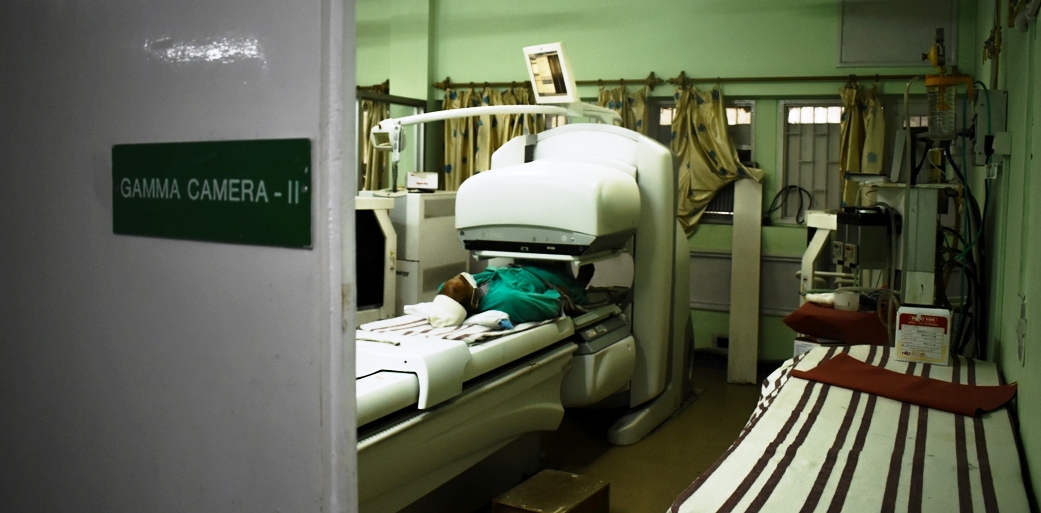Scanning human bodies for abnormal growth in various organs and subsequently treating them with radioactive substances is a job that pushes medical professionals to risk not anyway less than the patient they are treating, reports Syed Ahmad Rufai

On the right and left-hand side of the hallway leading to SKIMS’s department of nuclear medicine, 15 patients take the weight off their feet on steel benches, waiting for their turns. Several others brace themselves for their tests; some waiting inside the department premises and others in their respective restricted test rooms getting prepared and wearing uniforms for the procedure.
The department is the backbone for a variety of exclusive diagnostic tests for Kashmir. But it is run single-handedly by a faculty member and a small team of technologists and junior resident doctors. On a daily basis, this small team led by Dr Tanveer Ahmed Rather, an additional professor, tends to at least 150-200 patients. The department is responsible for PET-CT scan, Thyroid scan, bone scan, Parathyroid scan, Cardiac scan, Liver scan, Meckel’s scan, Gastrointestinal bleed scan, Iodine scan and renal scan.
“Almost 95 per cent of our activities are based on diagnostic tests and the remaining 5 per cent pertain to therapeutic treatment,” Dr Tanveer said while smiling at the result of a fortunate patient on his PET-CT machine, whose body recorded no unusual spots on the body. The machines use small amounts of radioactive substances to generate pictures of organs for a better understanding of new growth.
Safety Issues
Working in “hot” laboratories is seen as a health hazard and the professionals working inside are supposed to be extremely careful while handling the radioactive substances.

In the dose dispensing room, Taufeeq Ahmad, a senior technologist is preparing a dose for a patient. For making the dose, he hides behind a lead wall. “This protects us from the radiations that the radioactive material emits,” Taufeeq said. Adds Dr Tanveer: “Other than this, we use TLD, lead shield, glass goggles, thyroid shields, lead aprons and gloves in high dose preparations to avoid the radiations.” TLD’s are Thermo-luminescent dosimeters, which the staffers in the nuclear medicine use on their aprons at chest level and on wrists. This, Najeebullah Kirmani, a diploma holder in medical radioisotope techniques explains is a radiation detection device that monitors exposition to radiations. After every three months of use, these TLD’s are flown to Bhabha Atomic Research Centre, Mumbai for evaluation. “If someone’s reading is above the normal mark, they are sent to home isolation,” Najeeb said.
Gamma Camera
The department is equipped with two dual-head gamma cameras for general scans. These are the main tools for almost all the scans. With equipment and staff unchanged, the footfalls are up, against 4596 in 2018, it was 4980 in 2019.
“The department is capable of diagnosing and treating more patients but due to shortage of trained manpower, PET-CT scans are only done twice a week,” one staffer, who wishes to remain anonymous, said.
Dr Tanveer, however, said they are managing things. “In 2020, despite Covid190, we were able to diagnose and treat patients normally,” Dr Tanveer said. “On a daily basis, we have a footfall of 20-25 patients for general scans in addition to weekly 20 PET-CT’s and 5-6 Iodine-131 high and low doses. Advanced technology is helpful and there is a considerable reduction in the waiting time for scans and treatment.”
Patients used to wait for eight months for Iodine-131 high dose treatment but now it starts soon after the patient’s scan is over. For PET-CT, the waiting time has fallen to a few weeks. The scans are cost-effective in comparison to the private sector. General scans fall in Rs 500-Rs 3000 slabs; Iodine-131 high dose costs Rs 3000 and for a PET-CT only Rs 14,500 are charged.
In the huge SKIMS infrastructure, the Nuclear Medicine department operates on the ground floor and the third floor. There, Thyroid cancer patients are treated with a high dose of Iodine-131. Plans are afoot that the department will get “a three-storey building for its exclusive use, which will help patients from getting exhausted in the SKIMS maze.
Occupational Hazard
In this department, the danger is a perpetual issue. “The radioactively charged waste material should not be touched by anyone,” Taufeeq, a technologist, said. “It is disposed off by the hospital carefully.”

Dr Tanveer terms the radioactive substances as a stigmatized enemy. “We are scared of it, but it is to be understood that anything that is used for benefit of patients, becomes medicine,” he said. “Advantages overpower the disadvantages of radiations for medicinal use. We give fixed and controlled doses in accessible limits.”
So far, there has been no untoward issue for the staff in using the apparently hazardous material. Practically, the department is the only centre where this facility is available and, in a way, it is the only address in Jammu and Kashmir for some of the diagnostic studies.
Ideally, the people working with radioactive substances should have taken the stress from it. But in this department, Dr Tanveer said, it is the state of patients with cancer that gets them stress. “There are a lot of patients and a lot of work but the tensions come from the patients from diverse age groups who are scared of getting diagnosed or treated for cancer.”















